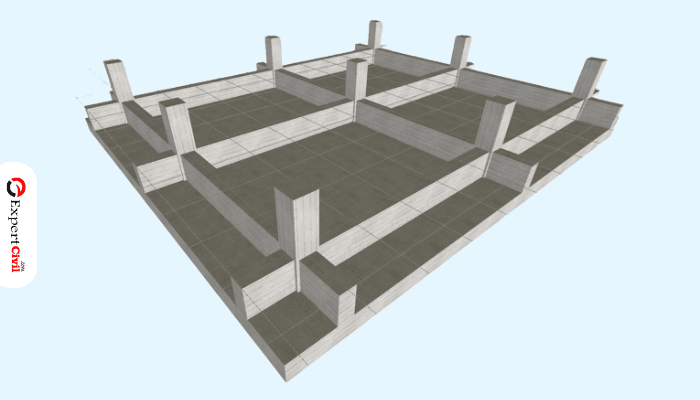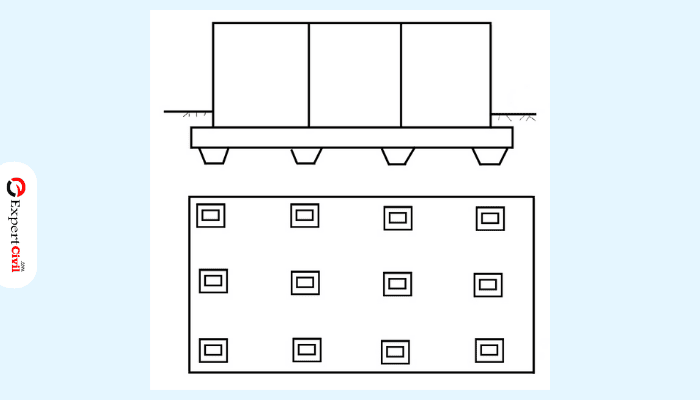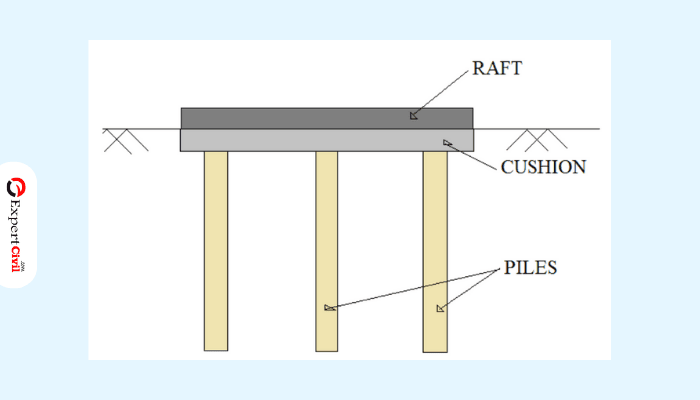Raft Foundation
Raft Foundation is also known as “Mat Foundation”. This type of foundation is used to spread the load from the entire structure to a large area. In this foundation entire structure is placed on the large continuous footing slab. In simple words, a raft foundation is a large continuous concrete slab used to transfer the entire load of the structure into the soil. This continuous flat concrete slab with heavily reinforced steel supports many columns and walls of the structure and thus helps in transmitting the load into the soil.
This type of foundation is commonly used for large projects of buildings, chimneys, large machinery, etc. Also, when the bearing capacity of the soil is weak, a raft foundation is used.

The raft foundations can also be stiffened by beams. It helps in reducing the settlement of the structure as such concrete slab resists all the different moments acting on it due to different loading positions.
In this foundation, the contact of the foundation with the ground is more as compared to other types of foundation which help the foundation to transmit the load from the structure into the large area and the stress on the soil is very less and also this reduced the failure of the structure due to shear.
This foundation is also very useful when the soil layers are unstable. It is considered a type of shallow foundation. It is also useful in controlling the differential settlement of the structure.
Also Read: Strap Footing – Its Types, Advantages & Disadvantages
Functions of Raft Foundation
- The main function of the raft is to transmit the entire superstructure into the large area of the ground.
- It also reduces the differential settlement of the structure.

Construction process of the Raft Foundation
The process of construction of the raft foundation includes the following steps:
- Excavation of soil up to the required depth and a flat level.
- The foundation bed is compacted properly.
- A waterproof membrane is provided.
- A 3” thick layer of cement sand paste is laid for making the flat surface of the foundation.
- Reinforcement steel mesh of required spacing and tied properly is laid on that layer of cement sand paste.
- After that concrete of required depth or thickness, that thickness is up to 200 mm to 300 mm for the small structure, is poured into it.
- Suitable curing should be provided such that concrete can achieve its required compressive strength.
Raft Foundation is the most commonly used foundation due to its simple construction process and effectiveness for the different types of soils.
Uses of Raft Foundation
- Raft foundation is used when the soil has low bearing strength.
- It is used when the load of the structure has to be distributed over a large area.
- It is economical to construct when the foundation area is 50% of the total ground area under the structure.
- It is used when the spacing between the columns or the walls is significantly less because in such situations individual footing would overlap.
- It is used when we have to reduce the stress level in the soil.
- It is used for structures where basements have to be constructed.
- When the soil strata are very compressible then this type of footing is best suitable.
- It is mostly employed for the construction of commercial buildings such as showrooms, malls, etc. because there is the need for a basement.
- It is also used when the soil layer is unstable.
Advantages of Raft Foundation
- Raft foundation provides a water barrier from the groundwater.
- Raft Foundation is very economical compared to other types of foundations.
- Raft Foundation also require very little excavation.
- It also helps in the reduction of different types of settlement of the structure.
- It can be used where the ground has a very poor condition.
- Raft Foundation is easy to construct and does not require any special labor.
- In this type of foundation, floors and slabs are combined which saves time and materials.
- It is a shallow type of foundation that does not require deep excavation.
- A raft foundation is an ideal foundation for the ground having low bearing strength because this foundation spreads. the loads very effectively as compared to other strip foundations on weak soils.
- Raft Foundation reduces the formation of cracks, settlement and other major problems of the structure.
- Raft Foundation is very cheaper and also very time savings.
Disadvantages of Raft Foundation
- If proper treatment is not done to this, it can lead to edge erosion.
- Also, require special treatment for point loads.
- Large amounts of quantity materials or things are required such as steel etc.
- It is not suitable for domestic use.
Types of Raft Foundation
1. Flat Plate Raft Foundation
This type of raft foundation is used when the loads from the columns are light and the spacing of the column is small relatively and also with uniformity. The raft provided is of uniform thickness. In this foundation, reinforcement is provided in both directions and extra reinforcement bars are provided in columns and load-bearing wall locations. It is the simplest form of the Raft foundation.

Flat Plate Raft Foundation
2. Thickened Flat Plate Type Raft Foundation
This type of raft foundation is useful when the column loads are heavy. In this foundation, the portion under the columns is thickened to provide suitable thickness for a negative bending moment. In this, extra reinforcement is provided under the columns and load-bearing walls to resist the diagonal shear and negative reinforcement.

Thickened Flat Plate Type Raft Foundation
3. Beam and Slab Type Raft Foundation
In this type of raft foundation, the two perpendicular beams are constructed or laid down and a slab I’d provided between them. This type of foundation is best suited when the spacing between the column is very large and the size of the column is unequal.

Beam and Slab Type Raft Foundation
4. Piled Raft Foundation
In this type of raft foundation, piles are placed as a support of the raft. This type of foundation is used when the soil is highly compressible and the water table is high. Piles help in reducing the settlement of the structure and also help in controlling buoyancy.

Piled Raft Foundation
5. Cellular Raft Foundation
This type of raft foundation is also known as a “Box Structure”. This foundation is provided in which the basement of the structure acts as a stiffener for the raft in the footing. If the chances of bending are high, this foundation is most suitable because this foundation can resist a high amount of bending. This foundation is very rigid. It is also economical if the required thickness of the slab is very high.

Cellular Raft Foundation
Also Read: Types Of foundation & Their Uses In Building Construction


A Raft Foundation is a solid slab of concrete that spreads across the entire area of a structure, supporting the building’s weight. It’s ideal for soft or uneven soils and heavy constructions. Types include flat, stepped, and piled raft foundations. Advantages include distributing loads evenly and reducing settlement. However, disadvantages involve higher costs and complexity in construction. It’s commonly used in residential buildings and industrial structures.
Raft foundations, also known as mat foundations, consist of a large concrete slab that supports the entire structure. Designed to distribute the building’s weight evenly, it is highly suitable for soils with weak or expansive properties. There are three types of foundations: solid slabs, slab beams, and cellular rafts. The main advantages of this method are its stability and cost-effectiveness, however, the drawbacks include the higher excavation costs and the need for skilled labor. For large structures or uneven terrain, this is the ideal solution.